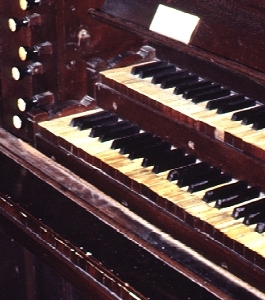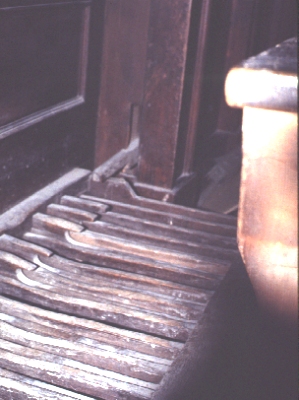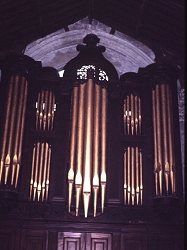Introduction
The organ in the Thaxted Parish Church was built by Henry Cephas Lincoln and installed in St. John's Chapel Bedford Row, London, in 1821. The instrument was later moved to its present location.197
The case is similar to those built by Snetzler and others in the middle and late eighteenth century. Its sides extend straight from the floor to the top of the side towers, the center tower is taller than the side towers, and pipes in the two-story flats separating the towers are displayed in a symmetrical pattern, here duplicated on both levels.
Organ Disposition
Great
FF,GG-f''' |
|
Choir
FF,GG-f''' |
|
Swell
e -f''' |
|
Pedal
FF-c |
| Open Diapason Front |
|
8 |
|
Dulciana |
|
8 |
|
Open Diapason |
|
8 |
|
Pedals |
|
8 |
|
| Open Diapason (C) |
|
8 |
|
Stopped Diapason |
|
8 |
|
Stopped Diapason |
|
8 |
|
| Stopped Diapason |
|
8 |
|
Principal |
|
4 |
|
Principal |
|
4 |
|
| Principal |
|
4 |
|
Flute |
|
4 |
|
Cremona |
|
8 |
|
| Twelfth |
|
2 2/3 |
|
Fifteenth |
|
2 |
|
Hautboy |
|
8 |
|
| Fifteenth |
|
2 |
|
Bassoon |
|
8 |
|
Trumpet |
|
8 |
|
| Sesquialtera IV |
|
|
|
| Cornet IV-III |
|
|
|
| Mixture II |
| Trumpet |
|
8 |
| |
| Couplers: |
Coupler Swell (Swell to Great)
Pedals Great (Great to Pedal)
Pedals Swell (Swell to Pedal) |
There are several elements in the stoplist that you should notice.198
- The extended keyboard compass means that a 16' stop is not needed to play low pitches - - they sound when the extra notes at the bass end of the keyboard are played.
- The "short octave" of the keyboard compass in this instance means that the low FF# is omitted.
- The "balance of power" has not shifted so far to the Swell in this instrument that it has taken a dominant place over the Choir. The Choir division
- has a full-compass keyboard, like the Great,
- and it has a chorus of three stops (Stopped Diapason, Principal and Fifteenth).
- There is a Swell to Great coupler, but no Choir to Great coupler. The crescendo effect of the Swell could be added to the power of the Great to produce an even greater "swelling" of the sound.
- The pedal stop is an open stop made of wood - - very similar to the 8' Flûte that you would have seen on a French Classical pedal a century earlier.
- Couplers allow the two-full-compass keyboards to be played from the pedal.
Photographs
 The case, showing the left tower (8' Open Diapason in the façade) and carvings. The case, showing the left tower (8' Open Diapason in the façade) and carvings.
 The keydesk, set into the case, as it usually was in the eighteenth and early nineteenth centuries. The keydesk, set into the case, as it usually was in the eighteenth and early nineteenth centuries.
 Close-up of manual keyboards. (The third keyboard is covered by the panel you see under the lower of the two visible keyboards. The hidden keyboard actually folds down when that panel is opened.) Close-up of manual keyboards. (The third keyboard is covered by the panel you see under the lower of the two visible keyboards. The hidden keyboard actually folds down when that panel is opened.)
Look at the bass end of the keyboards. You see two adjacent white keys first, then two groups of two black keys each. The lowest key is FF, the next GG, with no FF# between them.
 The upper end of the pedalboard. The rod that seems to be sticking out of the side of the case (over the treble keys) is the control for the swell shades. The balanced swell shoe that you are accustomed to seeing didn't exist in the 1820's. The upper end of the pedalboard. The rod that seems to be sticking out of the side of the case (over the treble keys) is the control for the swell shades. The balanced swell shoe that you are accustomed to seeing didn't exist in the 1820's.
|


 The case, showing the left tower (8' Open Diapason in the façade) and carvings.
The case, showing the left tower (8' Open Diapason in the façade) and carvings. The keydesk, set into the case, as it usually was in the eighteenth and early nineteenth centuries.
The keydesk, set into the case, as it usually was in the eighteenth and early nineteenth centuries. Close-up of manual keyboards. (The third keyboard is covered by the panel you see under the lower of the two visible keyboards. The hidden keyboard actually folds down when that panel is opened.)
Close-up of manual keyboards. (The third keyboard is covered by the panel you see under the lower of the two visible keyboards. The hidden keyboard actually folds down when that panel is opened.) The upper end of the pedalboard. The rod that seems to be sticking out of the side of the case (over the treble keys) is the control for the swell shades. The balanced swell shoe that you are accustomed to seeing didn't exist in the 1820's.
The upper end of the pedalboard. The rod that seems to be sticking out of the side of the case (over the treble keys) is the control for the swell shades. The balanced swell shoe that you are accustomed to seeing didn't exist in the 1820's.